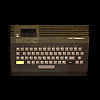
BASIC is a family of general-purpose, high-level programming languages designed for ease of use. The original version was created by John G. Kemeny and Thomas E. Kurtz at Dartmouth College in 1963. They wanted to enable students in non-scientific fields to use computers. At the time, nearly all computers required writing custom software, which only scientists and mathematicians tended to learn.
Programmed Inquiry, Learning, or Teaching (PILOT) is a simple high-level programming language developed in the 1960s. Like its younger sibling LOGO, it was an early foray into the technology of computer-assisted instruction.

Yabasic is a free, open-source BASIC interpreter for Microsoft Windows and Unix platforms. Yabasic was originally developed by Marc-Oliver Ihm, who released the last stable version 2.77.3 in 2016. From version 2.77.1, the project has adopted the MIT License as well as the source code being moved to GitHub to encourage others to participate in its development.
GRASS is a programming language created to script 2D vector graphics animations. GRASS was similar to BASIC in syntax, but added numerous instructions for specifying 2D object animation, including scaling, translation and rotation over time. These functions were directly supported by the Vector General 3D graphics terminal GRASS was written for. It quickly became a hit with the artistic community who were experimenting with the new medium of computer graphics, and is most famous for its use by Larry Cuba to create the original "attacking the Death Star will not be easy" animation in Star Wars (1977).

Atari BASIC is an interpreter for the BASIC programming language that shipped with the Atari 8-bit family of 6502-based home computers. Unlike most American BASICs of the home computer era, Atari BASIC is not a derivative of Microsoft BASIC and differs in significant ways. It includes keywords for Atari-specific features and lacks support for string arrays, for example.
Integer BASIC is a BASIC interpreter written by Steve Wozniak for the Apple I and Apple II computers. Originally available on cassette for the Apple I in 1976, then included in ROM on the Apple II from its release in 1977, it was the first version of BASIC used by many early home computer owners.
Sinclair BASIC is a dialect of the programming language BASIC used in the 8-bit home computers from Sinclair Research and Timex Sinclair. The Sinclair BASIC interpreter was made by Nine Tiles Networks Ltd.

TI BASIC is an ANSI-compliant BASIC programming language interpreter built into the 1979 Texas Instruments TI-99/4 home computer and its improved 1981 version, the TI-99/4A.

The ThomsonMO5 is a home computer introduced in France in June 1984 to compete against systems such as the ZX Spectrum and Commodore 64. It had a release price of 2390 FF.
FOCAL is an interactive interpreted programming language based on JOSS and mostly used on Digital Equipment Corporation (DEC) Programmed Data Processor (PDP) series machines.
HP Time-Shared BASIC is a BASIC programming language interpreter for Hewlett-Packard's HP 2000 line of minicomputer-based time-sharing computer systems. TSB is historically notable as the platform that released the first public versions of the game Star Trek.
Color BASIC is the implementation of Microsoft BASIC that is included in the ROM of the Tandy/Radio Shack TRS-80 Color Computers manufactured between 1980 and 1991. BASIC is a high level language with simple syntax that makes it easy to write simple programs. Color BASIC is interpreted, that is, decoded as it is run.
Galaksija BASIC was the BASIC interpreter of the Galaksija build-it-yourself home computer from Yugoslavia. While being partially based on code taken from TRS-80 Level 1 BASIC, which the creator believed to have been a Microsoft BASIC, the extensive modifications of Galaksija BASIC—such as to include rudimentary array support, video generation code and generally improvements to the programming language—is said to have left not much more than flow-control and floating point code remaining from the original.
IBM System/34 BASIC was an interpreter for the IBM System/34 midrange computer.

The Thomson TO7, also called Thomson 9000 is a home computer introduced by Thomson SA in November 1982, with an original retail price of 3750 FF. By 1983 over 40000 units were produced. About 84 games were released for the TO7.

In the 1980s the French Thomson company produced a range of 8-bit computers based on the 6809E CPU.
SCELBAL, short for SCientific ELementary BAsic Language, is a version of the BASIC programming language released in 1976 for the SCELBI and other early Intel 8008 and 8080-based microcomputers like the Mark-8. Later add-ons to the language included an extended math package and string handling. The original version required 8 kB of RAM, while the additions demanded at least 12 kB.

A BASIC interpreter is an interpreter that enables users to enter and run programs in the BASIC language and was, for the first part of the microcomputer era, the default application that computers would launch. Users were expected to use the BASIC interpreter to type in programs or to load programs from storage.
Wang BASIC is a series of BASIC programming languages for computers from Wang Laboratories. The term can be used to refer to the BASIC on any Wang machine, but is mostly associated with the versions on the Wang 2200 minicomputer series of the early 1970s. When these machines were updated to the VP series in 1976, BASIC-2 was introduced and remained the pattern for future machines in the 2200 series. A planned BASIC-3 was never released.
Acorn System BASIC and Atom BASIC are two closely related dialects of the BASIC programming language developed by Acorn Computers for their early microcomputers like the Acorn System 3 and Acorn Atom. Developed in-house, they have a number of significant idiosyncrasies compared to most BASIC dialects of the home computer era.








